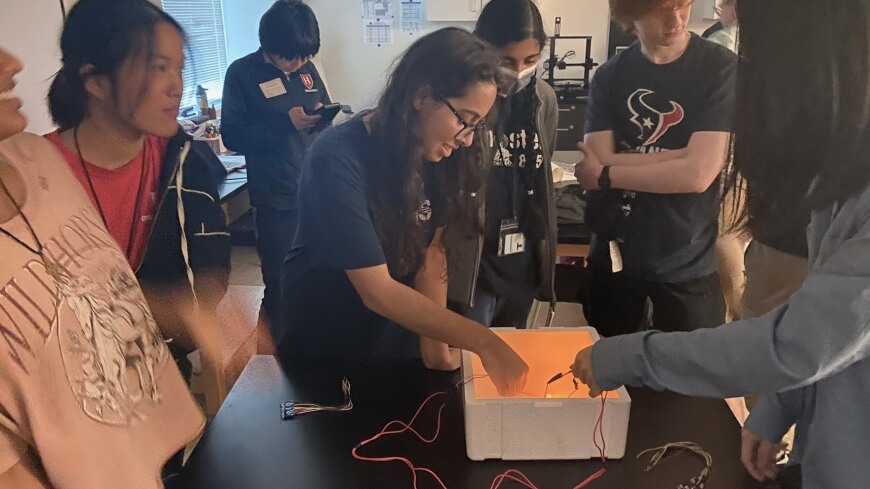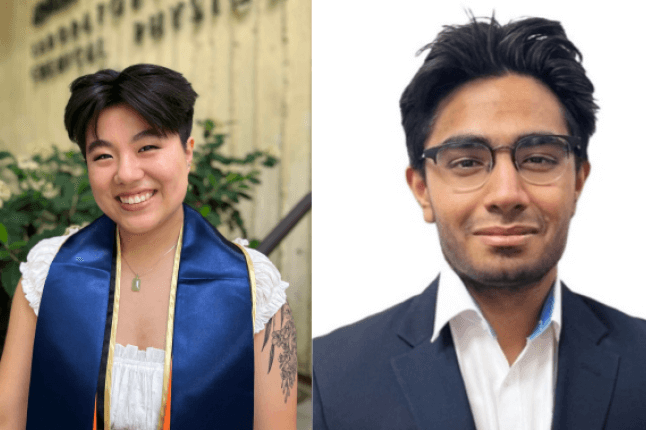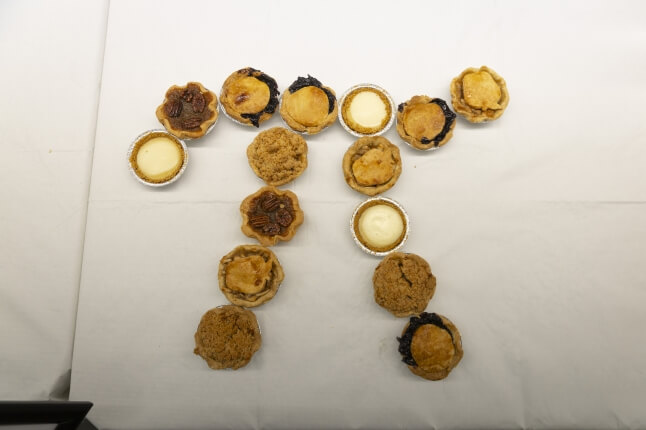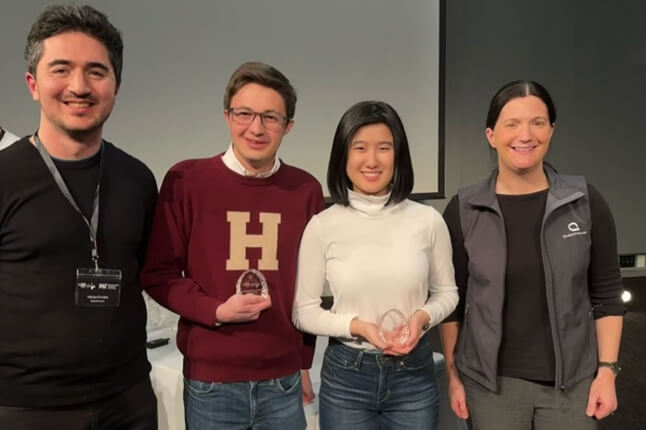News
Matthew Yeh and Jennifer Wang remember how changed they were by their first exposure to high-level scientific research. Yeh, an applied physics Ph.D. candidate at the Harvard John A. Paulson School of Engineering and Applied Sciences (SEAS), and Wang, an electrical engineering and computer science Ph.D. student at MIT, didn’t consider pursuing advanced scientific degrees until they participated in enrichment activities in high school.
“It really gave me a huge sense of creativity and agency that I hadn’t been exposed to before,” Wang said. “I had to read academic papers for the first time and synthesize a lot of information. It was all confusing, and no one knew what the answer was, and that was super exciting.”
Students from Bellaire High School in Texas experiment with submerging LEDs in liquid nitrogen during the "Quantum Engineering Research and You" outreach program. (Daniel Mark)
The duo now find themselves trying to be the mentors that can inspire the next generation of researchers in science, technology, engineering and mathematics (STEM). They started the “Quantum Engineering Research and You (QuERY)” outreach program for the Spring 2022 semester and repeated it again this past spring, connecting high school students from Wang’s alma mater in Houston, Bellaire High School, with current graduate and postdoctoral students at SEAS and MIT. Physics teacher and University of Houston Ph.D. candidate James Newland coordinated the students at Bellaire. The project is partially funded by the Harvard Quantum Initiative, which is co-directed by Evelyn Hu, Tarr-Coyne Professor of Applied Physics and of Electrical Engineering at SEAS, and whose executive committee includes nine SEAS faculty. Additional funding comes from the MIT Center for Quantum Engineering’s Interdisciplinary Quantum Information Science and Engineering program.
“It’s hard to say you’re interested in something if you’re not exposed to it,” Yeh said. “Part of our philosophy is to use quantum as a vehicle to get people interested in STEM. But another aspect is the mentor-mentee relationship. We want to make our graduate students and postdocs available as a resource if our high schoolers have questions.”
The program uses a hybrid format in which the students gather together in person, then work with their graduate mentors through Zoom. They study six different modules related to quantum science, but each module is designed to reframe the material into something directly related to their everyday lives.
People nowadays talk about quantum as if it’s this magic future technology. But quantum is already being used all around us! Your computer is filled with transistors that utilize quantum mechanics.
Students eventually form small groups and devise their own experiments that utilize the material they’ve studied, then present them at an end-of-semester poster session at Bellaire. Once the students have chosen their projects, Wang and Yeh match them with mentors specializing in similar fields.
“If they’re interested in coding, we’ll put them with mentors who use a lot of simulation techniques,” Wang said. “This is the creativity and agency that I really want to see: take the skills you have, synthesize them with what you’ve learned in the program, then come up with a project guided, but not driven, by the graduate mentor.”
Giving the students agency over their own scientific research has made for a wide range of quantum-related final projects. Students in the school band used an open-source software package to generate random numbers by simulating a quantum circuit, then made music using the results. Another group learned how to code so they could simulate a model of magnetism. Another group experimented with dipping LED lights into liquid nitrogen, changing the color of the emitted light as the extreme cold changed the lights’ crystal lattice structure.
“We found there was a remarkable amount of things they could do,” Yeh said. “In the first year, students did simulations or small literature reviews. But they came back this past spring and wanted to do something with their hands. They wanted to show off something for when the mentors flew in from Cambridge.”
QuERY is designed for juniors and seniors but takes underclassmen as well. The program had 25 students in its first year, then grew to 38 this past spring. Students with historically underrepresented gender identities and experiences made up half the group, a far cry from national averages among students studying STEM concentrations.
“We’re really helping even out the gender diversity in this space by giving underrepresented students a comfortable place to explore a new topic,” Wang said. “Their teacher says he believes this will be trajectory-changing for these students.” this to a new batch of students, and I think it’s exciting stuff.”
Jennifer Wang, electrical engineering and computer science Ph.D. student at MIT
Matthew Yeh, applied physics Ph.D. candidate at SEAS
Four of the other six QuERY mentors are from SEAS: post-baccalaureate researcher Katie Barajas, postdoctoral researcher David Barton, and applied physics Ph.D. candidates Scarlett Seejia Yu and Michael Haas.
“As a mentor I was there to help the students understand the material taught in lectures and complete their quantum engineering-related project,” Barajas said. “The heart of this program is to get students to start thinking like scientists. By learning from researchers in the field and learning about their career trajectory, students can start to envision themselves as scientists.”
Other mentors include Caolan John and Daniel Mark, both Ph.D. physics students at MIT.
“Remarkably quickly, we saw students staying in contact with our mentors,” Yeh said. “Just in June, I was told by one of our mentors that one of her students was in town and reached out for a tour of the lab.”
With two successful programs now complete, Wang and Yeh plan to run QuERY again in 2024.
“From hearing our students’ feedback, the general theme was that when compared to previous science enrichment activities, our program felt more personal because of the mentorship and relatability of the subject matter,” Yeh said. “We’re excited to bring this to a new batch of students, and I think it’s exciting stuff.”
Topics: Applied Physics, K-12, Quantum Engineering
Cutting-edge science delivered direct to your inbox.
Join the Harvard SEAS mailing list.
Press Contact
Matt Goisman | mgoisman@g.harvard.edu




